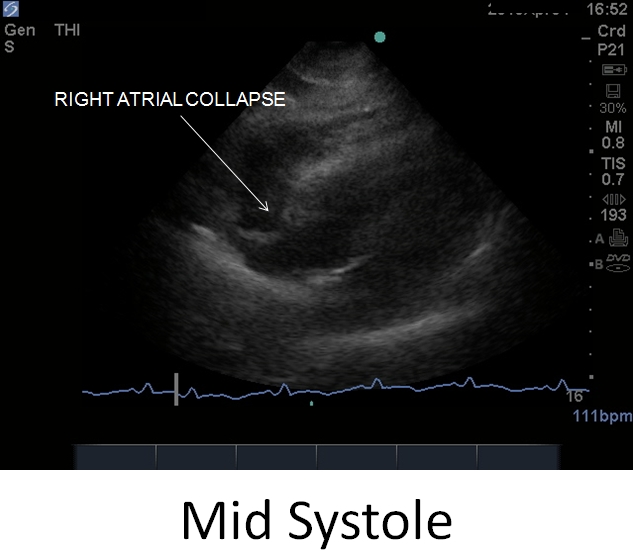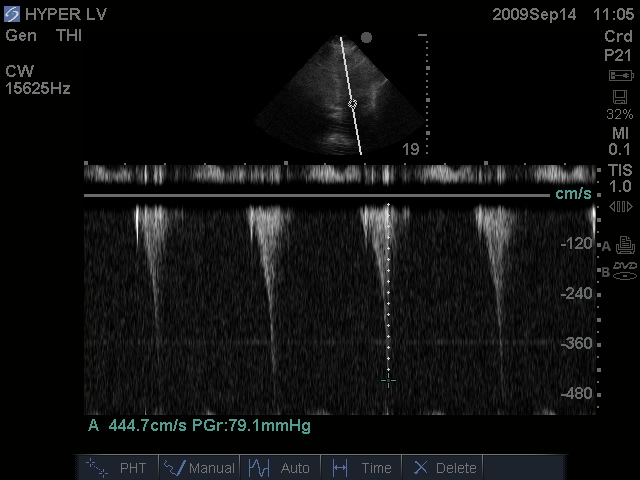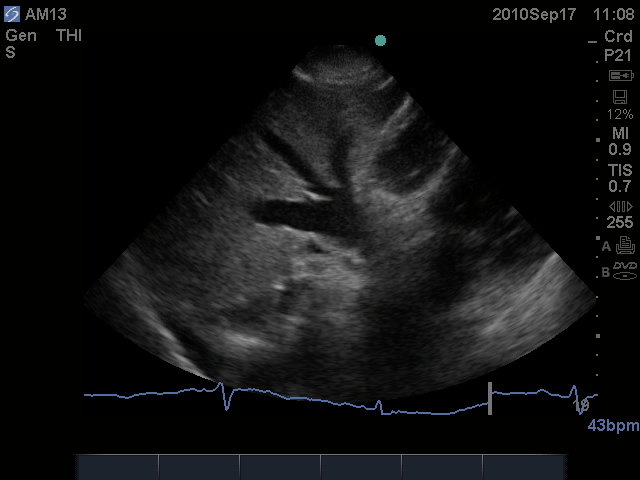Chapter 6 - Goal-directed Echocardiography in the ICU
Case 6-1. Hypotension and UrosepsisThis goal-directed echocardiography (GDE) was performed on a patient who presented with hypotension and urosepsis. By definition, GDE must include the parasternal long-axis view, the parasternal short-axis view, the apical four-chamber view, subcostal long-axis view, and the inferior vena cava view. Videos 6-1A through E show a normal GDE. Based on these results, the critical care team categorized the shock state as distributive without evidence of obstructive, cardiogenic, or hypovolemic shock. Phenylephrine was the primary pressor agent given for vasoplegia of sepsis. As the IVC was greater than 2.5 cm in diameter without much respiratory variation, no further volume resuscitation was indicated. A follow-up GDE was performed which is shown in Case 6-7. The heart is not completely visualized on the subcostal view due to shadowing from bowel gas. There is a possible echogenic structure adjacent to the right atrial free wall on the apical four-chamber view that is not visible in other views. This would warrant referral for an advanced echocardiography examination.
Case 6-2. Severe Hypotension and Respiratory Failure.
This goal-directed echocardiography (GDE) was performed on a patient who presented with severe hypotension and respiratory failure. Video 6-2A shows an attempt at the parasternal long-axis view. There are A lines with lung sliding. No cardiac structure is visible. Video 6-2B shows an attempt at the parasternal short-axis view. There are A lines with lung sliding. No cardiac structure is visible. Videos 6-2C1 and 6-2C2 show the apical four-chamber view. On 2D imaging, there is a possible defect in the interventricular septum (Video 6-2C1) that is confirmed with color flow Doppler (Video 6-2C2). Video 6-2D shows the subcostal long-axis view. There is a pericardial effusion with right atrial systolic compression and echogenic material in the effusion consistent with a hemopercardium. Video 6-2E shows the inferior vena cava (IVC) view. The IVC is enlarged. Case Figure 6-2 shows midsystolic right atrial collapse. Based on the GDE results, the patient was placed on an aortic balloon pump followed by emergency surgery that repaired an acute ventricular septal defect with an associated pseudoaneurysm and acute hemopericardium due to a left ventricular pseudoaneurysm. The patient made a full recovery. Early use of GDE identified an imminently life-threatening process that resulted in successful surgical intervention. It is common that some views of the GDE examination cannot be obtained, as in this patient due to hyperinflation. For this reason, it is important to attempt all five views. Frequently, the subcostal view is the best for patients with hyperinflation.

Figure 6-2. Midsystolic right atrial collapse
Case 6-3. Acute Dyspnea and Hypotension
This goal-directed echocardiography (GDE) was performed on a patient who presented with acute dyspnea and hypotension. Video 6-3A and 6-3B show the parasternal long-axis view. There is a mobile mass on the posterior mitral valve (MV) leaflet. Color flow Doppler shows severe mitral valve regurgitation. Video 6-3C shows the parasternal short-axis view. The left ventricular function is normal. Video 6-3D shows the apical four-chamber view. On this zoomed view, there is a mobile mass on the MV. Video 6-3E shows the subcostal long-axis view. This view is suboptimal for interpretation. Video 6-3F shows the inferior vena cava (IVC) view. The IVC diameter is large. Based on the GDE, major MV failure was identified. The patient was stabilized with an aortic balloon pump and underwent early and successful MV replacement. While the etiology of the MV failure cannot be determined by GDE, the examination identified an abnormality that required immediate escalation of support and cardiac surgery consultation. The parasternal short-axis view is off axis at times. This results from respiratory translational artifact. The subcostal view is not adequate for interpretation. It is common in the critically ill not to be able to obtain all views of the GDE examination.
Case 6-4. Severe Hypotension and Respiratory Distress
This goal-directed echocardiography (GDE) was performed on a patient who presented with severe hypotension and respiratory distress following a trans-Pacific flight. Video 6-4A shows the parasternal long-axis view. There is possible enlargement of the right ventricular (RV) outflow track. Video 6-4B shows the parasternal short-axis view. There is a "D" shaped left ventricle with possible enlargement of the RV. Video 6-4C shows the apical four-chamber view. There is a thrombus in transit in the right atrium, an enlarged RV, and McConnell's sign. Video 6-4D shows the subcostal long-axis view. There is a thrombus in transit in the right atrium and an enlarged RV. Video 6-4E shows the inferior vena cava view. There is a dilated IVC. Based on the GDE results, the patient underwent emergency surgical embolectomy with removal of the RA thrombus and multiple proximal pulmonary emboli. The patient made a full recovery. Early use of GDE identified an imminently life-threatening process that resulted in successful surgical intervention. Ideally, the interventricular septum should be orientated in the middle of the image for the apical four-chamber view. It is often difficult to obtain a good apical four-chamber view in the critically patient, due to problems with positioning the patient. When the RV is enlarged, it is also difficult to include both the RV and LV (left ventricle) in the same view.
Case 6-5. Progressive Hypotension
This goal-directed echocardiography (GDE) was performed for progressive hypotension. The patient presented with dyspnea and had a long history of hypertension. The admitting team treated the patient for congestive heart failure with diuretics. The patient developed hypotension and was started on dopamine. Escalating doses of dopamine resulted in further hypotension. The critical care team was called to evaluate the patient. Video 6-5A shows the parasternal long-axis view. The left ventricle (LV) is hyperdynamic with end-systolic effacement. Video 6-5B shows the parasternal short-axis view. The LV is hyperdynamic with end-systolic effacement. Video 6-5C shows the apical four-chamber view. The LV is hyperdynamic with end-systolic effacement. Video 6-5D shows the subcostal long-axis view. The LV is hyperdynamic with end-systolic effacement. Video 6-5E shows the inferior vena cava (IVC) view. The IVC diameter is small. This case is an example of inappropriate use of diuretics and an inotrope in a patient with an LV that that was conditioned by long-term hypertension. Based on the GDE, the critical care team gave immediate volume resuscitation, changed the dopamine to phenylephrine, and administered a dose of intravenous beta-blocker. The hypotension was promptly corrected with these measures. Early use of GDE allowed identification of dangerous inappropriate therapy. The examiner had difficulty in obtaining a consistent on axis apical four-chamber view due to translational artifact from respiratory activity. This is a common problem in the critically ill patient with respiratory distress. For the intensivist with advanced critical care echocardiography skill, the diagnosis of end systolic effacement that has physiological consequence may be confirmed by placing a continuous wave Doppler interrogation line through the LV cavity using the apical four-chamber view. The Doppler envelope has a characteristic end-systolic peak velocity (“dagger shaped”) profile, and the peak velocity is elevated (Case Figure 6-5). In this case, the end-systolic velocity gradient was 79 mmHg.

Figure 6-5. The Doppler envelope has a characteristic end-systolic peak velocity ("dagger shaped") profile, and the peak velocity is elevated.
Case 6-6. Hypotension with Left Ventricular Dysfunction
This goal-directed echocardiography (GDE) was performed on a patient with hypotension who had a known history of severe left ventricular (LV) dysfunction. Video 6-6A shows the parasternal long-axis view. There is severe global LV dysfunction. The valve anatomy is normal, but there is reduced mitral valve opening in diastole. A small pericardial effusion is present in association with a pleural effusion. Video 6-6B shows the parasternal short-axis view. This view confirms the findings of the parasternal long-axis view. Video 6-6C shows the apical four-chamber view. Endomyocardial definition is poor, so the image is suboptimal for interpretation. Video 6-6D shows the subcostal long-axis view. There is severe LV dysfunction. A small pericardial effusion is present. The echo free space in the near field represents ascites. Video 6-6E shows the inferior vena cava (IVC) view. The IVC is dilated. There is no video clip of the IVC, so respiratory variation cannot be determined. Based on the GDE results, the critical team categorized the shock state as cardiogenic in origin. Review of previous echocardiography reports showed no difference in LV dysfunction pattern. Obstructive and hypovolemic shock category were ruled with GDE. Review of the history, physical examination, and laboratory values identified no cause for coexisting distributive shock. The patient was treated for decompensated heart failure with diuretics and inotropic support and improved to baseline functional status. Following GDE, the critical care team called for advanced echocardiography study that included a dobutamine trial performed with multiple serial measurements of stroke volume and cardiac output with augmenting doses of dobutamine. This case emphasizes the importance of integrating all aspects of the clinical evaluation (history, physical examination, and laboratory results) with GDE. This allowed the team to exclude distributive shock. The GDE examination also identified that there was no need for volume resuscitation in this case and that there was a relative contraindication to its use as well. The apical four chamber is suboptimal, while the other views were sufficient to guide initial management. This supports the rule that every view of the standard GDE examination should be included when evaluating the patient in shock.

Figure 6-6E. IVC view. The IVC is dilated.
Case 6-7. Hypotension Related to Urosepsis
This goal-directed echocardiography (GDE) was performed 24 h following admission on a patient who presented with hypotension related to urosepsis. The initial GDE was normal (see Case 6-1). The patient was on norepinephrine at the time of the second GDE. Video 6-7A shows the parasternal long-axis view: There is severely reduced left ventricular function and segmental wall abnormality involving the inferolateral basal and midsegments. This is new from the initial GDE. Video 6-7B shows the parasternal short-axis view. This confirms the findings of the parasternal long-axis view. The apical four-chamber view is not shown due to inadequate image quality. Video 6-7C shows the subcostal long-axis view. There is severely reduced left ventricular (LV) function. Video 6-7D shows the inferior vena cava (IVC) view. The IVC is dilated. Video 6-7E shows the anterior chest lung examination. There are multiple profuse B lines present bilaterally. The GDE examination done 24 h after admission shows new severely reduced LV function with a segmental wall abnormality. This underlines the dynamic quality of GDE findings in the critically ill patient. In this case, the patient developed a sepsis cardiomyopathy. The team was concerned about the segmental wall abnormality. Cardiac enzymes and EKG were negative, and so that the segmental wall abnormality was a manifestation of the sepsis cardiomyopathy. The dilated IVC indicated that there would be no further benefit from volume resuscitation, while the profuse B line pattern informed that there was specific contraindication to further fluid infusion. The patient was continued on norepinephrine to provide both inotropic and pressor support and improved with antibiotics. A GDE performed two weeks later was normal. Sepsis cardiomyopathy is often fully reversible. The apical four-chamber view is often the most difficult to achieve in the critically ill patient, as demonstrated by this case.
Case 6-8. Pneumonia with Septic Shock
This goal-directed echocardiography (GDE) was performed for an elderly patient with an established diagnosis of pneumonia with septic shock. Video 6-8A shows the parasternal long-axis view. There is severe reduction in left ventricular function (LV) with segmental wall abnormality involving the mid- and basal anterior septum. The aortic valve is hyperechoic and immobile consistent with aortic stenosis (AS). The mitral valve (MV) is hyperechoic and has reduced systolic opening. Video 6-8B shows the parasternal short-axis view. There is severe reduction in left ventricular function with segmental wall abnormality. Video 6-8C shows the apical four-chamber view. There is severe reduction in left ventricular function. The anterolateral wall is not well seen. A right-sided pacer wire is in place. The apical subcostal view is not shown due to inadequate image quality. Video 6-8D shows the inferior vena cava (IVC) view. The IVC is dilated. This case demonstrates the importance of performing GDE in all patients with shock. The diagnosis of septic shock was made by history, physical examination, thoracic ultrasonography that identified pneumonia, and laboratory analysis. Standard treatment using the “sepsis bundle” approach would mandate substantial volume resuscitation in this situation. The GDE examination identified reduced LV function with segmental wall abnormality and significant AS. Vigorous volume resuscitation would not help this patient and could well be harmful. The presence of what might be severe AS with segmental wall abnormality, suggesting ischemic cardiac risk greatly complicates the medical management of this elderly patient. The GDE examination should be followed by an advanced critical care echocardiography examination in order to quantitate the severity of the AS as well as to further characterize the function of the MV.